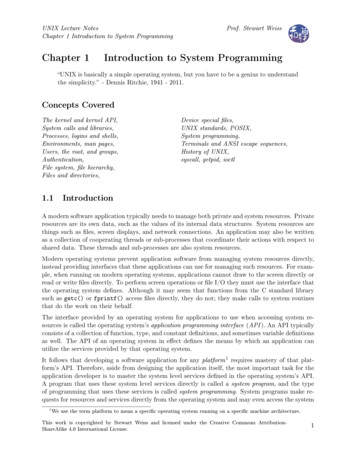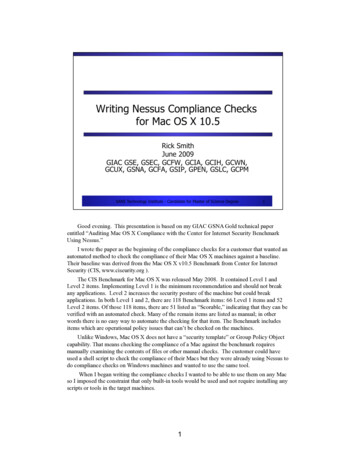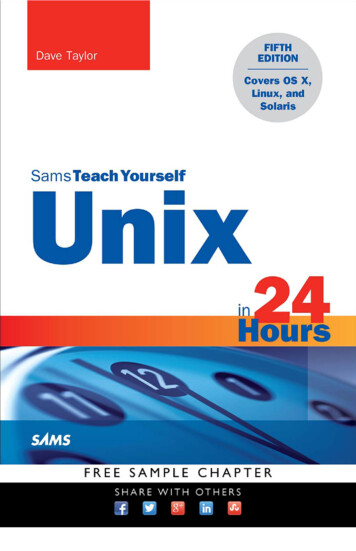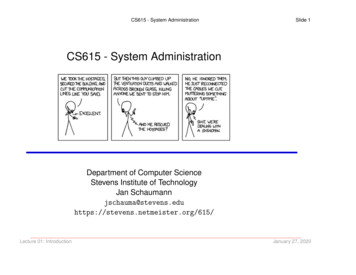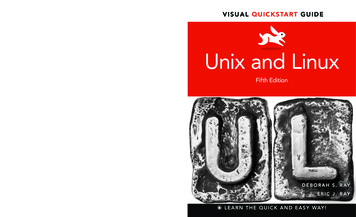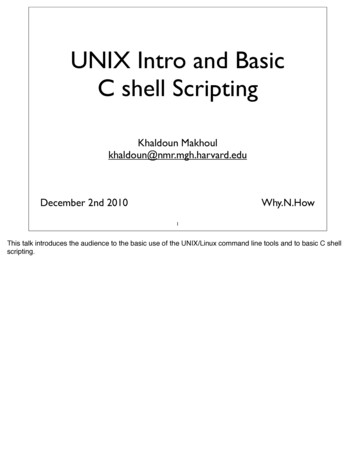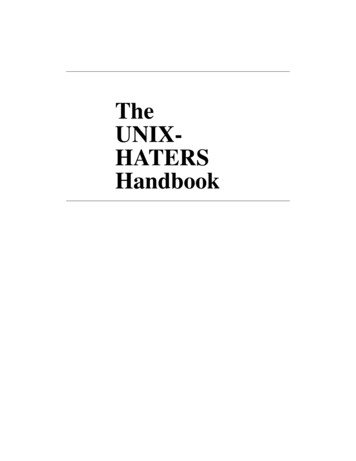
Transcription
TheUNIXHATERSHandbook
TheUNIX-HATERSHandbook“Two of the most famous products of Berkeley are LSD and Unix.I don’t think that is a coincidence.” IDGBOOKSEdited by Simson Garfinkel,Daniel Weise,and Steven StrassmannPROGRAMMERSIllustrations by John KlossnerPRESS
ivIDG Books Worldwide, Inc.An International Data Group CompanySan Mateo, California Indianapolis, Indiana Boston, MassachusettsThe UNIX-HATERS HandbookPublished byIDG Books Worldwide, Inc.An International Data Group Company155 Bovet Road, Suite 310San Mateo, CA 94402Copyright 1994 by IDG Books Worldwide.All rights reserved.No part of this book (including interior design, cover design, and illustrations) may bereproduced or transmitted in any form, by any means, (electronic, photocopying, recording, orotherwise) without the prior written permission of the publisher.ISBN 1-56884-203-1Printed in the United States of AmericaFirst Printing, May, 199410 9 8 7 6 5 4 3 2 1Distributed in the United States by IDG Books Worldwide, Inc.Distributed in Canada by Macmillan of Canada, a Division of Canada Publishing Corporation;by Computer and Technical Books in Miami, Florida, for South America and the Caribbean;by Longman Singapore in Singapore, Malaysia, Thailand, and Korea; by Toppan Co. Ltd. inJapan; by Asia Computerworld in Hong Kong; by Woodslane Pty. Ltd. in Australia and NewZealand; and by Transword Publishers Ltd. in the U.K. and Europe.For information on where to purchase IDG’s books outside the U.S., contact Christina Turnerat 415-312-0633.For information on translations, contact Marc Jeffrey Mikulich, Foreign Rights Manager, atIDG Books Worldwide; FAX number: 415-358-1260.For sales inquires and special prices for bulk quantities, contact Tony Real at 415-312-0644.Trademarks: Unix is a trademark of Novell. All brand names and product names used in thisbook are trademarks, registered trademarks, or trade names of their respective holders. IDGBooks Worldwide is not associated with any product or vendor mentioned in this book.Limit of Liability/Disclaimer of Warranty: The authors and publisher of this book haveused their best efforts in preparing this book. IDG Books Worldwide, Inc., International DataGroup, Inc., and the authors make no representation or warranties with respect to the accuracyor completeness of the contents of this book, and specifically disclaim any implied warrantiesor merchantability or fitness for any particular purpose, and shall in no event be liable for any
vloss of profit or any other commercial damage, including but not limited to special, incidental,consequential or other damages.
viTo Ken and Dennis,without whom this bookwould not have been possible.
viiCreditsVice President and PublisherChris WilliamsSenior EditorTrudy NeuhausImprint ManagerAmorette PedersenProduction ManagerBeth JenkinsCover DesignKavish & KavishBook Design and ProductionSimson Garfinkel & Steven Strassmann
viiiAbout IDG Books WorldwideWelcome to the world of IDG Books Worldwide.IDG Books Worldwide, Inc., is a subsidiary of International Data Group,the worlds largest publisher of business and computer-related informationand the leading global provider of information services on informationtechnology. IDG was founded over 25 years ago and now employs morethan 5,700 people worldwide. IDG publishes over 195 publications in 62countries. Forty million people read one or more IDG publications eachmonth.Launched in 1990, IDG Books is today the fastest growing publisher ofcomputer and business books in the United States. We are proud to havereceived 3 awards from the Computer Press Association in recognition ofeditorial excellence, and our best-selling “ For Dummies” series has over7 million copies in print with translations in more than 20 languages. IDGBooks, through a recent joint venture with IDG’s Hi-Tech Beijing, becamethe first U.S. publisher to publish a computer book in The People’s Republic of China. In record time, IDG Books has become the first choice formillions of readers around the world who want to learn how to better manage their businesses.Our mission is simple: Every IDG book is designed to bring extra valueand skill-building instruction to the reader. Our books are written byexperts who understand and care about our readers. The knowledge base ofour editorial staff comes from years of experience in publishing, education,and journalism—experience which we use to produce books for the 90s. Inshort, we care about books, so we attract the best people. We devote specialattention to details such as audience, interior design, use of icons, and illustrations. And because we write, edit, and produce our books electronically,we can spend more time ensuring superior content and spend less time onthe technicalities of making books.You can count on our commitment to deliver high quality books at competitive prices on topics you want to read about. At IDG, we value quality, andwe have been delivering quality for over 25 years. You’ll find no betterbook on a subject than an IDG book.John KilcullenPresident and CEOIDG Books Worldwide, Inc.
ix
x
Table of ContentsForeword . xvBy Donald A. NormanPreface . xixThings Are Going to Get a Lot WorseBefore Things Get WorseWho We Are. xxiThe UNIX-HATERS History .xxiiiContributors and Acknowledgments. xxixTypographical Conventions . xxxiiThe UNIX-HATERS Disclaimer .xxxiiiAnti-Foreword . xxxvBy Dennis RitchiePart 1: User Friendly?. 11 Unix . 3The World’s First Computer VirusHistory of the Plague. 4Sex, Drugs, and Unix . 9Standardizing Unconformity. 10Unix Myths . 14ix
x2 Welcome, New User! .17Like Russian Roulette with Six Bullets LoadedCryptic Command Names .18Accidents Will Happen.19Consistently Inconsistent.26Online Documentation .31Error Messages and Error Checking, NOT! .31The Unix Attitude.373 Documentation? .43What Documentation?On-line Documentation .44This Is Internal Documentation? .51For Programmers, Not Users.54Unix Without Words: A Course Proposal .564 Mail.61Don’t Talk to Me, I’m Not a Typewriter!Sendmail: The Vietnam of Berkeley Unix .62Subject: Returned Mail: User Unknown .67From: MAILER-DAEMON@berkeley.edu .74Apple Computer’s Mail Disaster of 1991.855 Snoozenet .93I Post, Therefore I AmNetnews and Usenet: Anarchy Through Growth .93Newsgroups .96Alt.massive.flamage .100This Information Highway Needs Information .100rn, trn: You Get What You Pay for .101When in Doubt, Post .105Seven Stages of Snoozenet.106
xi6 Terminal Insanity . 111Curses! Foiled Again!Original Sin . 111The Magic of Curses . 1147 The X-Windows Disaster .123How to Make a 50-MIPS Workstation Run Like a4.77MHz IBM PCX: The First Fully Modular Software Disaster.124X Myths.127X Graphics: Square Peg in a Round Hole .141X: On the Road to Nowhere .142Part 2: Programmer’s System? .1458 csh, pipes, and find .147Power Tools for Power FoolsThe Shell Game .148Shell Programming.155Pipes .161Find.1669 Programming .173Hold Still, This Won’t Hurt a BitThe Wonderful Unix Programming Environment .175Programming in Plato’s Cave.176“It Can’t Be a Bug, My Makefile Depends on It!”.186If You Can’t Fix It, Restart It! .198
xii10 C .203The COBOL of the 90sThe Assembly Language ofObject-Oriented Programming .204Syntax Syrup of Ipecac.208Abstract What? .211C Is to C as Lung Cancer Is to Lung .214The Evolution of a Programmer .215Part 3: Sysadmin’s Nightmare .21911 System Administration .221Unix’s Hidden CostKeeping Unix Running and Tuned .223Disk Partitions and Backups.227Configuration Files.235Maintaining Mail Services .239Where Did I Go Wrong? .24112 Security .243Oh, I’m Sorry, Sir, Go Ahead,I Didn’t Realize You Were RootThe Oxymoronic World of Unix Security .243Holes in the Armor .244The Worms Crawl In .25713 The File System .261Sure It Corrupts Your Files,But Look How Fast It Is!What’s a File System? .262UFS: The Root of All Evil.265
xiii14 NFS .283Nightmare File SystemNot Fully Serviceable.284No File Security.287Not File System Specific? (Not Quite).292Part 4: Et Cetera .303A Epilogue.305Enlightenment Through UnixB Creators Admit C, Unix Were Hoax .307FOR IMMEDIATE RELEASEC The Rise of Worse Is Better . 311By Richard P. GabrielD Bibliography .317Just When You Thought You Were Out of the Woods Index .319
ForewordBy Donald A. NormanThe UNIX-HATERS Handbook? Why? Of what earthly good could it be?Who is the audience? What a perverted idea.But then again, I have been sitting here in my living room—still wearingmy coat—for over an hour now, reading the manuscript. One and one-halfhours. What a strange book. But appealing. Two hours. OK, I give up: Ilike it. It’s a perverse book, but it has an equally perverse appeal. Whowould have thought it: Unix, the hacker’s pornography.When this particular rock-throwing rabble invited me to join them, Ithought back to my own classic paper on the subject, so classic it even gotreprinted in a book of readings. But it isn’t even referenced in this one.Well, I’ll fix that:Norman, D. A. The Trouble with Unix: The User Interface is Horrid.Datamation, 27 (12) 1981, November. pp. 139-150. Reprinted inPylyshyn, Z. W., & Bannon, L. J., eds. Perspectives on the ComputerRevolution, 2nd revised edition, Hillsdale, NJ, Ablex, 1989.What is this horrible fascination with Unix? The operating system of the1960s, still gaining in popularity in the 1990s. A horrible system, exceptthat all the other commercial offerings are even worse. The only �–––––––––––––Copyright 1994 by Donald A. Norman. Printed with permission.
xvi Forewordsystem that is so bad that people spend literally millions of dollars trying toimprove it. Make it graphical (now that’s an oxymoron, a graphical userinterface for Unix).You know the real trouble with Unix? The real trouble is that it became sopopular. It wasn’t meant to be popular. It was meant for a few folks working away in their labs, using Digital Equipment Corporation’s old PDP-11computer. I used to have one of those. A comfortable, room-sized machine.Fast—ran an instruction in roughly a microsecond. An elegant instructionset (real programmers, you see, program in assembly code). Toggleswitches on the front panel. Lights to show you what was in the registers.You didn’t have to toggle in the boot program anymore, as you did with thePDP-1 and PDP-4, but aside from that it was still a real computer. Not likethose toys we have today that have no flashing lights, no register switches.You can’t even single-step today’s machines. They always run at fullspeed.The PDP-11 had 16,000 words of memory. That was a fantastic advanceover my PDP-4 that had 8,000. The Macintosh on which I type this has64MB: Unix was not designed for the Mac. What kind of challenge is therewhen you have that much RAM? Unix was designed before the days ofCRT displays on the console. For many of us, the main input/output devicewas a 10-character/second, all uppercase teletype (advanced users had 30character/second teletypes, with upper- and lowercase, both). Equippedwith a paper tape reader, I hasten to add. No, those were the real days ofcomputing. And those were the days of Unix. Look at Unix today: the remnants are still there. Try logging in with all capitals. Many Unix systemswill still switch to an all-caps mode. Weird.Unix was a programmer’s delight. Simple, elegant underpinnings. The userinterface was indeed horrible, but in those days, nobody cared about suchthings. As far as I know, I was the very first person to complain about it inwriting (that infamous Unix article): my article got swiped from my computer, broadcast over UUCP-Net, and I got over 30 single-spaced pages oftaunts and jibes in reply. I even got dragged to Bell Labs to stand up infront of an overfilled auditorium to defend myself. I survived. Worse, Unixsurvived.Unix was designed for the computing environment of then, not themachines of today. Unix survives only because everyone else has done sobadly. There were many valuable things to be learned from Unix: howcome nobody learned them and then did better? Started from scratch andproduced a really superior, modern, graphical operating system? Oh yeah,
xviiand did the other thing that made Unix so very successful: give it away toall the universities of the world.I have to admit to a deep love-hate relationship with Unix. Much though Itry to escape it, it keeps following me. And I truly do miss the ability (actually, the necessity) to write long, exotic command strings, with mysterious,inconsistent flag settings, pipes, filters, and redirections. The continuingpopularity of Unix remains a great puzzle, even though we all know that itis not the best technology that necessarily wins the battle. I’m tempted tosay that the authors of this book share a similar love-hate relationship, butwhen I tried to say so (in a draft of this foreword), I got shot down:“Sure, we love your foreword,” they told me, but “The only truly irksomepart is the ‘c’mon, you really love it.’ No. Really. We really do hate it. Anddon’t give me that ‘you deny it—y’see, that proves it’ stuff.”I remain suspicious: would anyone have spent this much time and effortwriting about how much they hated Unix if they didn’t secretly love it? I’llleave that to the readers to judge, but in the end, it really doesn’t matter: Ifthis book doesn’t kill Unix, nothing will.As for me? I switched to the Mac. No more grep, no more piping, no moreSED scripts. Just a simple, elegant life: “Your application has unexpectedly quit due to error number –1. OK?”Donald A. NormanApple FellowApple Computer, Inc.And while I’m at it:Professor of Cognitive Science, EmeritusUniversity of California, San Diego
PrefaceThings Are Going to Get a Lot WorseBefore Things Get Worse“I liken starting one’s computing career with Unix, say as an undergraduate, to being born in East Africa. It is intolerably hot, yourbody is covered with lice and flies, you are malnourished and yousuffer from numerous curable diseases. But, as far as young EastAfricans can tell, this is simply the natural condition and they livewithin it. By the time they find out differently, it is too late. Theyalready think that the writing of shell scripts is a natural act.”— Ken Pier, Xerox PARCModern Unix1 is a catastrophe. It’s the “Un-Operating System”: unreliable,unintuitive, unforgiving, unhelpful, and underpowered. Little is more frustrating than trying to force Unix to do something useful and nontrivial.Modern Unix impedes progress in computer science, wastes billions of dollars, and destroys the common sense of many who seriously use it. Anexaggeration? You won’t think so after reading this book.1Once upon a time, Unix was a trademark of AT&T. Then it was a trademark ofUnix Systems Laboratories. Then it was a trademark of Novell. Last we heard,Novell was thinking of giving the trademark to X/Open, but, with all the recent dealmaking and unmaking, it is hard to track the trademark owner du jour.
xx PrefaceDeficient by DesignThe original Unix solved a problem and solved it well, as did the Romannumeral system, the mercury treatment for syphilis, and carbon paper. Andlike those technologies, Unix, too, rightfully belongs to history. It wasdeveloped for a machine with little memory, tiny disks, no graphics, nonetworking, and no power. In those days it was mandatory to adopt an attitude that said: “Being small and simple is more important than being complete andcorrect.” “You only have to solve 90% of the problem.” “Everything is a stream of bytes.”These attitudes are no longer appropriate for an operating system that hostscomplex and important applications. They can even be deadly when Unixis used by untrained operators for safety-critical tasks.Ironically, the very attributes and design goals that made Unix a successwhen computers were much smaller, and were expected to do far less, nowimpede its utility and usability. Each graft of a new subsystem onto theunderlying core has resulted in either rejection or graft vs. host disease withits concomitant proliferation of incapacitating scar tissue. The Unix networking model is a cacophonous Babel of Unreliability that quadrupled thesize of Unix’s famed compact kernel. Its window system inherited thecryptic unfriendliness of its character-based interface, while at the sametime realized new ways to bring fast computers to a crawl. Its new systemadministration tools take more time to use than they save. Its mailer makesthe U.S. Postal Service look positively stellar.The passing years only magnify the flaws. Using Unix remains an unpleasant experience for beginners and experts alike. Despite a plethora of finebooks on the subject, Unix security remains an elusive goal at best. Despiteincreasingly fast, intelligent peripherals, high-performance asynchronous I/O is a pipe dream. Even though manufacturers spend millions developing“easy-to-use” graphical user interfaces, few versions of Unix allow you todo anything but trivial system administration without having to resort tothe 1970s-style teletype interface. Indeed, as Unix is pushed to be more andmore, it instead becomes less and less. Unix cannot be fixed from theinside. It must be discarded.
Who We Are xxiWho We AreWe are academics, hackers, and professionals. None of us were born in thecomputing analog of Ken Pier’s East Africa. We have all experiencedmuch more advanced, usable, and elegant systems than Unix ever was, orever can be. Some of these systems have increasingly forgotten names,such as TOPS-20, ITS (the Incompatible Timesharing System), Multics,Apollo Domain, the Lisp Machine, Cedar/Mesa, and the Dorado. Some ofus even use Macs and Windows boxes. Many of us are highly proficientprogrammers who have served our time trying to practice our craft uponUnix systems. It’s tempting to write us off as envious malcontents, romantic keepers of memories of systems put to pasture by the commercial success of Unix, but it would be an error to do so: our judgments are keen, oursense of the possible pure, and our outrage authentic. We seek progress, notthe reestablishment of ancient relics.
xxii PrefaceOur story started when the economics of computing began marching us,one by one, into the Unix Gulag. We started passing notes to each other. Atfirst, they spoke of cultural isolation, of primitive rites and rituals that wethought belonged only to myth and fantasy, of depravation and humiliations. As time passed, the notes served as morale boosters, frequently usingblack humor based upon our observations. Finally, just as prisoners whoplot their escape must understand the structure of the prison better thantheir captors do, we poked and prodded into every crevice. To our horror,we discovered that our prison had no coherent design. Because it had nostrong points, no rational basis, it was invulnerable to planned attack. Ourrationality could not upset its chaos, and our messages became defeatist,documenting the chaos and lossage.This book is about people who are in abusive relationships with Unix,woven around the threads in the UNIX-HATERS mailing list. These notesare not always pretty to read. Some are inspired, some are vulgar, somedepressing. Few are hopeful. If you want the other side of the story, go reada Unix how-to book or some sales brochures.This book won’t improve your Unix skills. If you are lucky, maybe youwill just stop using Unix entirely.The UNIX-HATERS HistoryThe year was 1987, and Michael Travers, a graduate student at the MITMedia Laboratory, was taking his first steps into the future. For yearsTravers had written large and beautiful programs at the console of his Sym-
The UNIX-HATERS History xxiiibolics Lisp Machine (affectionately known as a LispM), one of two stateof-the-art AI workstations at the Lab. But it was all coming to an end. Inthe interest of cost and efficiency, the Media Lab had decided to purge itsLispMs. If Travers wanted to continue doing research at MIT, he discovered, he would have to use the Lab’s VAX mainframe.The VAX ran Unix.MIT has a long tradition of mailing lists devoted to particular operatingsystems. These are lists for systems hackers, such as ITS-LOVERS, whichwas organized for programmers and users of the MIT Artificial Intelligence Laboratory’s Incompatible Timesharing System. These lists are forexperts, for people who can—and have—written their own operating systems. Michael Travers decided to create a new list. He called it UNIXHATERS:Date:From:To:Subject:Thu, 1 Oct 87 13:13:41 EDTMichael Travers mt UNIX-HATERSWelcome to UNIX-HATERSIn the tradition of TWENEX-HATERS, a mailing list for surly folkwho have difficulty accepting the latest in operating system technology.If you are not in fact a Unix hater, let me know and I’ll remove you.Please add other people you think need emotional outlets for theirfrustration.The first letter that Michael sent to UNIX-HATERS included a well-reasoned rant about Suns written by another new member of the Unix Gulag:John Rose, a programmer at a well-known Massachusetts computer manufacturer (whose lawyers have promised not to sue us if we don’t print thecompany’s name). Like Michael, John had recently been forced to give upa Lisp Machine for a computer running Unix. Frustrated after a week oflost work, he sent this message to his company’s internal support mailinglist:
xxiv PrefaceDate:From:To:Fri, 27 Feb 87 21:39:24 ESTJohn Rosesun-users, systemsPros and Cons of SunsWell, I’ve got a spare minute here, because my Sun’s editor windowevaporated in front of my eyes, taking with it a day’s worth of Emacsstate.So, the question naturally arises, what’s good and bad about Suns?This is the fifth day I’ve used a Sun. Coincidentally, it’s also the fifthtime my Emacs has given up the ghost. So I think I’m getting a feelfor what’s good about Suns.One neat thing about Suns is that they really boot fast. You ought tosee one boot, if you haven’t already. It’s inspiring to those of uswhose LispMs take all morning to boot.Another nice thing about Suns is their simplicity. You know how aLispM is always jumping into that awful, hairy debugger with theconfusing backtrace display, and expecting you to tell it how to proceed? Well, Suns ALWAYS know how to proceed. They dump acore file and kill the offending process. What could be easier? Ifthere’s a window involved, it closes right up. (Did I feel a draft?)This simplicity greatly decreases debugging time because you immediately give up all hope of finding the problem, and just restart fromthe beginning whatever complex task you were up to. In fact, at thispoint, you can just boot. Go ahead, it’s fast!One reason Suns boot fast is that they boot less. When a LispM loadscode into its memory, it loads a lot of debugging information too. Forexample, each function records the names of its arguments and localvariables, the names of all macros expanded to produce its code, documentation strings, and sometimes an interpreted definition, just forgood measure.Oh, each function also remembers which file it was defined in. Youhave no idea how useful this is: there’s an editor command called“meta-point” that immediately transfers you to the source of anyfunction, without breaking your stride. ANY function, not just one ofa special predetermined set. Likewise, there’s a key that causes thecalling sequence of a function to be displayed instantly.
The UNIX-HATERS History xxvLogged into a Sun for the last few days, my Meta-Point reflex hascontinued unabated, but it is completely frustrated. The program thatI am working on has about 80 files. If I want to edit the code of afunction Foo, I have to switch to a shell window and grep for namedFoo in various files. Then I have to type in the name of the appropriate file. Then I have to correct my spelling error. Finally I have tosearch inside the file. What used to take five seconds now takes aminute or two. (But what’s an order of magnitude between friends?)By this time, I really want to see the Sun at its best, so I’m tempted toboot it a couple of times.There’s a wonderful Unix command called “strip,” with which youforce programs to remove all their debugging information. Unix programs (such as the Sun window system) are stripped as a matter ofcourse, because all the debugging information takes up disk spaceand slows down the booting process. This means you can’t use thedebugger on them. But that’s no loss; have you seen the Unix debugger? Really.Did you know that all the standard Sun window applications(“tools”) are really one massive 3/4 megabyte binary? This allowsthe tools to share code (there’s a lot of code in there). Lisp Machinesshare code this way, too. Isn’t it nice that our workstations protectour memory investments by sharing code.None of the standard Sun window applications (“tools”) supportEmacs. Unix applications cannot be patched either; you must havethe source so you can patch THAT, and then regenerate the application from the source.But I sure wanted my Sun’s mouse to talk to Emacs. So I got a couple hundred lines of co
UNIX-HATERS Handbook . millions of readers around the world who want to learn how to better man-age their businesses. Our mission is simple: Every IDG book is designed to bring extra value and skill-bui

